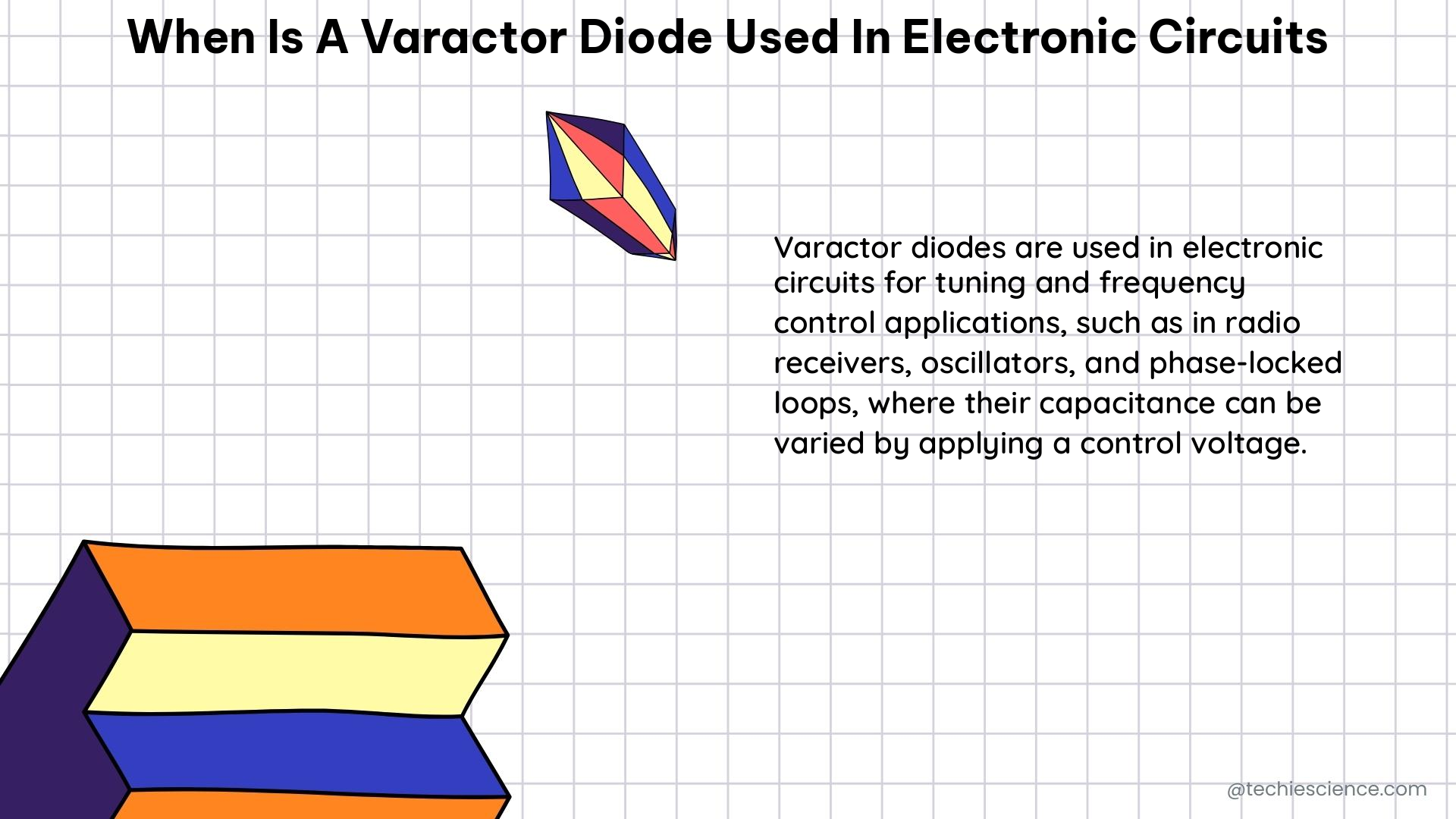Varactor diodes, also known as variable capacitance diodes or tuning diodes, are semiconductor devices that exhibit a voltage-dependent capacitance. This unique property makes them invaluable in a wide range of electronic circuits, particularly in applications that require precise frequency control, tuning, and signal processing.
Understanding Varactor Diodes
Varactor diodes are essentially reverse-biased p-n junction diodes, where the depletion region width varies with the applied reverse-bias voltage. This variation in the depletion region width directly affects the capacitance of the diode, allowing it to function as a voltage-controlled capacitor.
The capacitance of a varactor diode can be calculated using the formula:
C = C0 * (1 + V/Φ)^-γ
Where:
– C is the capacitance of the varactor diode
– C0 is the zero-bias capacitance
– V is the reverse-bias voltage
– Φ is the built-in potential of the p-n junction
– γ is a constant that depends on the doping profile of the diode
The capacitance of a varactor diode can vary significantly with the applied reverse-bias voltage, typically ranging from a few picofarads (pF) to hundreds of picofarads. This voltage-dependent capacitance is the key feature that makes varactor diodes so useful in electronic circuits.
Applications of Varactor Diodes

Frequency Tuning and Filtering
One of the primary applications of varactor diodes is in frequency tuning circuits, such as those found in radio, television, and wireless communication systems. By varying the reverse-bias voltage applied to the varactor diode, the capacitance can be adjusted, which in turn changes the resonant frequency of the tuned circuit. This allows for precise and electronic control of the operating frequency, enabling features like channel selection, frequency hopping, and frequency agility.
Varactor diodes are also used in filtering applications, where their voltage-dependent capacitance is used to dynamically adjust the frequency response of the circuit. This is particularly useful in multi-channel systems, where varactor diodes can be used to select and filter specific frequency bands.
Voltage-Controlled Oscillators (VCOs)
Varactor diodes are essential components in voltage-controlled oscillators (VCOs), which are widely used in phase-locked loops (PLLs) and frequency synthesizers. In a VCO, the varactor diode is used to control the oscillation frequency by varying the reverse-bias voltage applied to it. This allows for the generation of frequency-modulated (FM) signals, which are crucial in various communication and signal processing applications.
Radar and Aerospace Applications
Varactor diodes play a crucial role in radar and aerospace systems, where their frequency agility and signal processing capabilities are highly valued. In radar systems, varactor diodes are used in frequency-modulated continuous-wave (FMCW) radar sensors, enabling the detection and tracking of nearby objects, such as vehicles and aircraft. In aerospace communication systems, varactor diodes are used in frequency-hopping and spread-spectrum techniques to ensure confidentiality and resilience against jamming.
Automotive Collision Avoidance Systems
In automotive collision avoidance systems, varactor diodes are used as key components in FMCW radar sensors. These sensors detect the speed and distance of surrounding vehicles and obstacles, allowing the driver to take appropriate action to avoid collisions.
IoT and Smart Home Applications
Varactor diodes are also finding applications in the rapidly growing field of the Internet of Things (IoT) and smart home technologies. In these systems, varactor diodes are used for frequency modulation and channel selection, enabling efficient data transmission and remote control of various devices and sensors.
Advantages of Varactor Diodes
- Compact Size: Varactor diodes are small, lightweight, and easily integrated into electronic circuits, making them suitable for miniaturized and portable applications.
- High Frequency Operation: Varactor diodes can operate at high frequencies, up to the microwave range, making them suitable for RF and wireless communication applications.
- Precise Frequency Control: The voltage-dependent capacitance of varactor diodes allows for precise and electronic control of the operating frequency, enabling features like channel selection and frequency agility.
- Reliability and Durability: Varactor diodes are generally reliable and durable, with a long lifespan and resistance to environmental factors like temperature and vibration.
- Low Power Consumption: Varactor diodes typically have low power consumption, making them suitable for battery-powered and energy-efficient applications.
Conclusion
Varactor diodes are versatile and indispensable components in a wide range of electronic circuits and systems. Their unique voltage-dependent capacitance makes them invaluable in applications that require precise frequency control, tuning, and signal processing, such as wireless communication, radar, aerospace, automotive, and IoT systems. As technology continues to evolve, the applications of varactor diodes are likely to expand, further solidifying their importance in the world of electronic design and innovation.
References:
- Using a varactor diode to tune a resonance frequency, Electronics Stack Exchange, 2016-11-12.
- Varactor Diodes, Skyworks, 2008-08-15.
- i need help varicap(varactor), All About Circuits, 2018-02-11.
- Applications of Varactor Diode, GeeksforGeeks, 2024-05-02.
- The Varicap or Varactor Diode, RF tutorials, YouTube, 2021-02-20.

The lambdageeks.com Core SME Team is a group of experienced subject matter experts from diverse scientific and technical fields including Physics, Chemistry, Technology,Electronics & Electrical Engineering, Automotive, Mechanical Engineering. Our team collaborates to create high-quality, well-researched articles on a wide range of science and technology topics for the lambdageeks.com website.
All Our Senior SME are having more than 7 Years of experience in the respective fields . They are either Working Industry Professionals or assocaited With different Universities. Refer Our Authors Page to get to know About our Core SMEs.